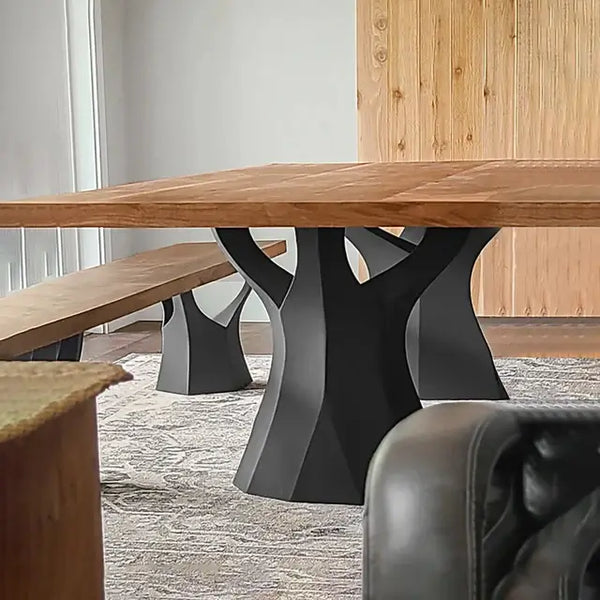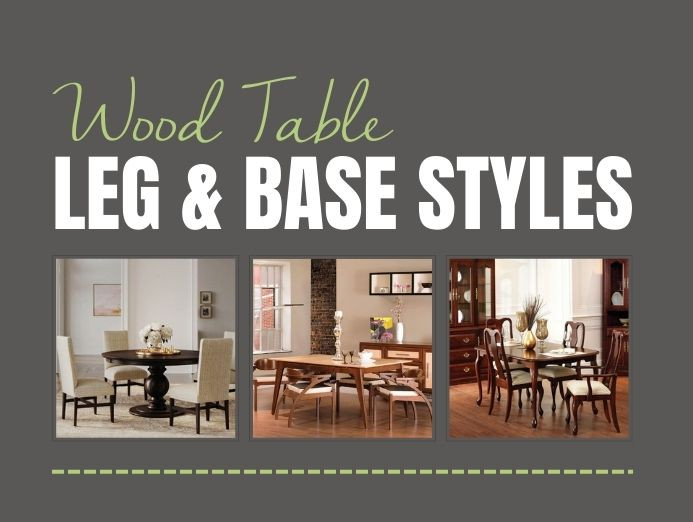From Conventional to Modern: Find the Perfect Dining Room Table Legs for Your Design
The choice of dining-room table legs plays a pivotal duty in specifying the general personality of your room, bridging the void between traditional workmanship and modern aesthetics. While timeless designs such as cabriole and transformed legs evoke a feeling of ageless sophistication, modern styles like hairpin and geometric alternatives provide a possibility for striking visual passion. Evaluating the best equilibrium between these designs calls for a nuanced understanding of your existing design and individual taste. As you think about these elements, the concern continues to be: how can you effortlessly incorporate these diverse leg styles to develop an unified dining experience?
Comprehending Table Leg Styles
The selection of eating area table leg designs can dramatically affect both the aesthetics and functionality of the space. Each leg design adds one-of-a-kind aesthetic aspects and functional functions, accommodating varied style choices and use needs. Recognizing these designs is vital for picking the ideal dining table that aligns with your overall interior decoration vision.
As an example, tapered legs supply a tidy, timeless look that can boost an area's sophistication, while pedestal bases provide security and make the most of legroom, making them perfect for smaller rooms. Hairpin legs, a hallmark of mid-century modern-day style, introduce a commercial style, permitting a ventilated, open feel. Similarly, trestle legs stimulate rustic appeal, providing durable support and a feeling of timelessness.
Additionally, the choice of products plays a considerable duty. Wooden legs can bring heat and structure, whereas steel choices often communicate a sleek, contemporary ambiance. Eventually, recognizing table leg styles is crucial for producing a natural dining location that mirrors personal design while ensuring functionality and convenience. By thoughtfully thinking about these aspects, you can boost both the practical and visual appeal of your dining area.
Typical Table Leg Options
When selecting dining-room table legs, traditional choices usually embody timeless beauty and craftsmanship. These styles mirror an abundant heritage and a dedication to quality, making them perfect for those who appreciate traditional visual appeals.
One of the most renowned standard leg designs is the cabriole leg, defined by its stylish rounded form. This style commonly includes ornamental makings and is most generally found in Queen Anne and Chippendale furnishings. An additional preferred alternative is the transformed leg, which flaunts a series of smooth, rounded shapes that offer a classic look while maintaining stability.
Furthermore, the straight leg, while straightforward, supplies a basic and strong structure that can blend effortlessly with a range of tabletop styles. For those drawn to ornate detailing, claw-and-ball feet legs stimulate a feeling of majesty and can act as a spectacular centerpiece in any eating area.
Finally, pedestal bases, although not purely legs, supply an alternate traditional alternative that permits for adequate legroom and can be magnificently carved. Each of these traditional leg designs adds to the overall setting of Website a dining-room, weding function with visual charm.

Modern Table Leg Designs
Modern table leg styles provide a varied variety of designs that emphasize tidy lines and innovative products. These styles frequently focus on functionality while acting as striking focal factors within a dining room. Minimalist appearances are common, with legs crafted from products such as metal, glass, and crafted timber, which add to a ventilated and modern feeling.
One popular style is the barrette leg, characterized by its slim, conical structure that supplies security without overwhelming the tabletop (dining room table legs). This design is often discovered in mid-century modern-day furniture and can effortlessly match numerous table shapes. One more fad is the use of geometric shapes, where legs might handle angular or unbalanced forms, adding visual rate of interest and a touch of artistry

Blending Styles for Unique Spaces
Often, homeowners look for to produce special eating rooms that show their personal style by mixing different style elements. This method enables the unification of varied looks, leading to a harmonious yet distinctive setting. Pairing a rustic wood table with smooth, modern steel legs can develop an attractive contrast that raises the area's overall charm.
Additionally, incorporating vintage table legs with modern table tops can evoke a sense of history while keeping a modern sensibility. Such mixes not just display specific taste yet likewise encourage imagination, allowing house owners to curate a space that really feels both individual and welcoming.
Shade plays a critical function in this mixing procedure; selecting table legs that complement or contrast with the existing color pattern can improve aesthetic passion. Whitewashed legs can soften the daring of a dark table surface area, creating a well balanced aesthetic.
Tips for Picking the Right Legs
Picking the right table legs is vital for accomplishing both performance and aesthetic appeal in your dining area. Begin by thinking about the overall design of your space. Traditional settings gain from legs that feature elaborate makings or transformed layouts, while contemporary spaces may require streamlined, minimal designs.
Following, analyze the height and stability of the legs. dining room table legs. Conventional table range between 28 to 30 inches in height, so guarantee the legs complement this measurement for convenience. In addition, robust materials, such as wood or steel, can enhance stability and long life
Review the leg shape as well-- options include straight, tapered, or stand styles. Straight legs offer a timeless appearance, while conical legs can include a touch of style. Pedestal bases give enough legroom and are excellent for smaller areas.
Verdict
In recap, selecting the suitable eating area table legs requires mindful consideration of both conventional and contemporary designs. Traditional choices such as cabriole and turned legs offer timeless style, while modern-day styles like hairpin and geometric forms supply a contemporary touch. By balancing leg style, height, and material with the general design, a natural and inviting environment can be attained. Eventually, the picked table legs need to mirror the preferred visual, boosting the dining experience within the area.
The selection of dining area table leg designs can significantly affect both the looks and capability of the area. Inevitably, comprehending table leg designs is essential for developing a cohesive eating location that mirrors personal style while ensuring usefulness and comfort.One of the most famous typical leg styles is the cabriole leg, identified by its elegant bent form. Straight legs provide a timeless look, while conical legs can include a touch of sophistication.In summary, selecting the excellent dining room table legs requires cautious consideration of both modern-day and standard designs.
Comments on “The Top Trends in Dining Room Table Legs You Need to Know”